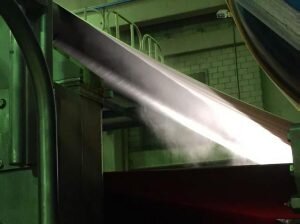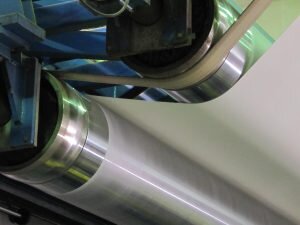How to maximize Paper Machine Clothing value through innovation

Guideline to set up your paper machine trials
This article is the follow up on the previous article about Dependency on PMC suppliers. Below I’d like to share the practical principles and actions that spring from an innovative mindset, ensuring a paper mill gets maximum value from its paper machine clothing.
You can read them as guidelines in making your paper mill and paper machine future proof, ensuring a competitive advantage.
All paper machines are different with their own complexities, so I trust you to recognize how the principles and hands-on strategies apply to your situation.
Warning
Once you realize there is an actual HOW to innovate and improve your paper machine performance, it will become harder to deny the necessity of making changes that may seem inconvenient at first, but are highly profitable in the end.
For the purpose of this blog, I’ll share 3 important principles:
Realize your paper machine, and its clothing, is not a black box.
Define an objective target that can be translated into money.
Know how to brief and select the PMC supplier for your trial.

Part 1. Realize Your Paper Machine, and Its Clothing, Is Not A Black Box
Almost out of despair some papermakers see their Machine Clothing, in combination with a capricious machine, as a complicated black box, which could be one of the reasons why they are quite happy to leave it all to the supplier.
Talking about black boxes: in the scientific world they have a thing called a complex system. This is a system composed of many components which may interact with each other. Its behavior is difficult to predict due to all the dependencies, relationships and other interactions between its components.
Doesn’t that sound like a paper machine? With machine clothing being one of those components?
Most people work problem-oriented. First a problem is defined, then the cause of this problem is investigated and finally a solution is developed to eliminate the cause of the problem. However, in a complex system it is often impossible to find the root cause, and even if you do, you most likely cannot eliminate it without creating new problems somewhere else.
For complex systems it is more functional to work solution-oriented. This requires a little mind shift: focus on the desired outcome, not on the problems. It is no news that every machine has its bad days. But not all problems appear all the time. There are always times when the machine is running fine. When you work solution-oriented, you focus on the good times.
These positive exceptions are the gateway to solutions. Investigate what is different those days, compared to most of the bad days. Note that from a psychological point of view it is also much nicer to focus on why things are going well. Studying the positive releases energy and people are much more cooperative compared to problem investigations which often lead to blame and defensive behavior.
Conclusion: even complex systems such as machine clothing in paper machines can be optimized in a structured way.
Part 2. Define One Objective Target That Can Be Translated Into Money
When looking at your machine clothing and comparing the good and the bad times, you may notice many different things. The bad times of the machine may coincide with the break-in phase of a felt or the end-of-life of a forming fabric. The number of web breaks in the wet-end of the machine might be substantially different. Good times may show far less vibrations in the fourth press. You can probably find numerous things. But when you start optimizing a complex system, you must focus on one goal only with no more than two or three conditions.

You can’t manage what you can’t measure’ – Peter Drucker
It is very important that you have a very clear vision of your performance goal and how much money you’ll save when your goal is achieved. You need a one objective metric (KPI) that can be translated into money. This will provide the necessary management support for your decision to experiment with new machine clothing. It will also create the highest chance of an outcome that will make both the production and the financial managers happy.
An example: you might have discovered that during good times you have two web breaks per day, compared to an overall average of three breaks per day. In that case your goal could be no more than two breaks per day, under the condition that the average machine speed and paper quality remain as they are now. Don’t be tempted to also imagine a higher machine speed or anything else, focus on only one improvement at a time, everything else will have to stay “as they are now”.
When an average web break lasts 20 minutes, reducing the number of web breaks from three to two per day will give you 1.45% more production per day. This can easily be translated into hard dollars. In this example the KPI would be less than 2 web breaks per day.
The KPI you select must be relevant, measurable, and as objective as possible. The complexity of a paper machine, the many parameters that influence the total result, is often used as an excuse for not being able to set clear goals and select supporting KPIs. When setting the goals, simply ignore the external factors.
Once you start measuring and collecting data you can always decide to exclude certain data points because they were temporarily not relevant.
Example KPIs Related To Machine Clothing
Apart from the number of web breaks per day in the wet-end, you could use some of the following KPIs to monitor the performance of paper machine clothing:
Break-in time: the maximum number of hours it takes after a felt installation to get back to a certain machine speed. The yield is more production per felt lifecycle.
Amount of steam (in the first dryer section) per ton of paper: this a good indicator for the dry content of the sheet exiting the press section, hence the dewatering efficiency of the forming and press section together. Less steam consumption = money saved.
Dollars of retention chemicals per ton of paper: with new forming fabrics you may need less expensive chemicals to obtain the same paper properties.
Time to install fabrics or felts: if the replacement of machine clothing is the bottle neck in your shutdown planning, this could be a perfect KPI. Again, the yield is more production per felt lifecycle.
The following KPIs are possible too, although they have their limitations.
Dry content of the sheet is a difficult one. At most machines it is not easy to objectively measure the sheet dryness at the exit of the forming or press section. Usually the automatic measuring frames are located further down the machine, so its test results are already affected by many other components in the machine as well.
Produced tons per felt or fabric: if your machine is not speed-limited the produced number of tons is a good derivative of the sheet dryness. The higher the dryness at the forming and/or press section, the higher the machine speed and the output. This KPI is not perfect because it is not directly related to machine clothing; it is not specific.
Keep your goals and KPIs realistic. Discuss the desired target with your current supplier and two or three new suppliers. It is essential that the goal is achievable.
There Is More Than Meets The Eye
When determining and calculating your KPI, take as many relevant factors into account as possible. For example, if your Machine Clothing trial reduces the number of maintenance shutdowns per year by 2, you’ll have more production time. But you also must factor in the savings in the maintenance department, for instance, in the reduced need for temporary workers.
Hold on to the thought…
EVERYTHING has its price.
Bear in mind…
Water is never free. You need to pump it, clean it, maybe pay duties. All this needs to be paid.
Steam is not free either. So include the costs for fresh water, the energy costs to make it, for maintenance of the boiler and piping, etc.
Maintenance staff and equipment have a price.
Calculate realistic prices for your resources. Some omit or use very low steam prices in their calculations because “it’s already part of the Kraft line”. Think again. What could be done with the steam you would save? Could the Kraft line produce more? Could the offices be heated? Could the excess steam be sold to a neighboring factory?
Production managers are more likely to see and seize opportunities for savings and performance improvement when the financial department can make them aware of real resource prices and how these prices are determined.
As a production manager, you should push the ‘bookkeepers’ to give you detailed, inclusive numbers
and keep on pushing until they do. Obviously financial experts are also more likely to see and seize opportunities for savings when the production department can give them insight in the production process with its hidden treasures of future savings.
A habit of knowledge sharing between Production and Finance will result in better investment decisions altogether, not limited to Paper Machine Clothing trials.
With a realistic grip on the financial potential, a paper mill can determine the acceptable return on investment for the project.
How To Calculate Your Machine Clothing Trial Budget, think of it as an investment
When you start trials with felts or fabrics, you will experience ups and downs. You may have to cut a piece prematurely and it might even require an unplanned shutdown. So how do you avoid the costs of trials getting too high? The answer is: by making a budget and carefully monitoring it.
For easier understanding I will use an example calculation which is completely fictional.
Current production of the machine: 360,000 tons per year = 1,000 ton/day = 42 ton/h
Sales price is $ 1,000/ton, the contribution margin is 30%.
If the machine runs, it makes $ 12,600/h (42 ton/h * $ 1,000/ton * 30%)
So far, so good. Now let’s use the situation where we want to reduce the number of wet-end breaks from three to two per day, each lasting twenty minutes. This would result in 1.45% more production.This company requires a ROI of 6 months or less.
Hence the investment budget for the trials is: 1.45% * 1000 ton/day * 180 days * $ 1,000/ton * 30% margin = $ 783,000
If during the ROI period of 180 days money is saved somewhere else, like energy costs, these savings can be added to the investment budget.
In this example there is a budget for machine clothing trials of close to $ 800,000 to cover the costs for:
additional felts and fabrics – expect 2 or 3 trials that need to be cut early;
additional downtime – the installation time required to replace the prematurely cut trials;
temporary suboptimal production quantity – allow a certain loss during 3 to 4 trials;
temporary suboptimal production quality – this should be kept to an absolute minimum;
other items, depending on the specifics of the trial.
Now that you have a goal, a KPI to monitor progress and a budget, it is time for the next step.
Part 3. Briefing And Selecting The Paper Machine Clothing Supplier
The next step will be to select a supplier to do the trials with. Because you have established the metrics, target and budget, it will be relatively easy to brief potential suppliers and set up agreements where both parties benefit from the results of the trial.

WARNING, or rather strong advice: stick to working with only one supplier per trial to keep focus.
It is wise to include your current supplier in the selection and give them a fair chance if they are open to this win-win opportunity. You never know how they might surprise you if you show them you are serious about getting the absolute best possible performance from your felts and fabrics.
At the same time and for reasons mentioned in the first section of this paper, bringing a new supplier on board from time to time will create the dynamics that stimulate innovation and better results in areas you may not expect.
Practical Tip To Bring A New PMC Supplier Faster On To Steam.
A new supplier has a disadvantage compared to the current supplier: he does not know the ‘normal’ of your machine. After all, a certain machine setting or felt property can be normal for one machine and completely off for another. This is why machine clothing suppliers need a frame of reference for every machine they supply. They can build that themselves by doing service measurements for months, but it is costly and time-consuming.
Time is money. If you can make more money with your machine, you would rather start today than in six months. The production manager can help to minimize the learning curve for a new supplier by building this “Machine Clothing frame of reference” and making it available to new suppliers.

The best time for collecting PMC datasets and papermachine datasets is during smooth operational periods when no hiccups or interruptions are happening. This will result in a reference datasheet the supplier will need to understand the specific properties of your paper machine under normal/good reference circumstances.
Such a smooth period cannot be predicted, only observed. The opportunity needs to be seized. This means that-ever present-the machine production staff is in the best position to compose the reference dataset. Even more so because under ‘smooth sailing’ conditions the operators are most likely to find the necessary time. Another advantage of the mill composing a proper dataset is that all measurements will be done with one set of instruments, instead of every PMC supplier bringing its own gear with unknown calibrations and unknown accuracies.
This article is shown in the final part, section three “How a mill took advantage of PMC trials” a case study with a European paper mill.
So remember DDPP - Daily Data Powers Production.
Toward better Paper Machine Clothing,
Marcel


